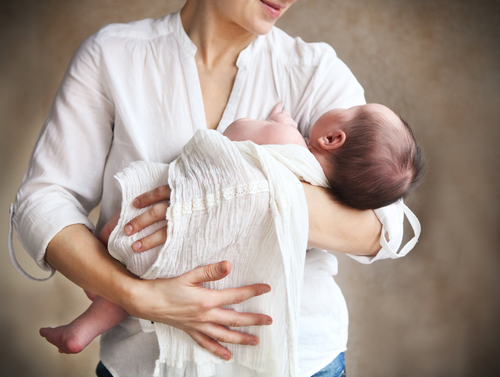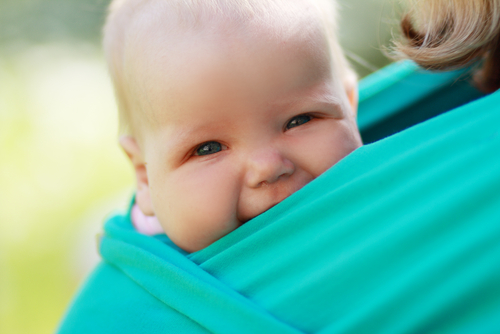The fact is that the baby needs to get a certain set of sensations and experiences when interacting with his mother. If the baby is deprived of this experience, then it will be difficult for him to develop harmoniously in the future. Therefore, most modern pediatricians and psychologists argue that the desire of a newborn to be in the arms of his mother is his natural need, necessary for the normal growth of the baby.
Why carry a child in your arms?
The world for a newborn is his mother. During pregnancy, especially during the last months of gestation, the baby's body is in the amniotic fluid and is compressed by the walls of the uterus. The unborn baby feels warm, calm and cozy there. After birth, the child seems to find himself in a completely different world, where he becomes uncomfortable and scared.
The sensations of a little person are divided into familiar ones from life in the womb before birth and unfamiliar ones. The former are associated with a source of peace and pleasure, while the new ones, on the contrary, are fraught with danger and threat. Maintaining the same guidelines can only be achieved through the constant presence of his mother next to the newborn. Her smell, touch, heartbeat and breathing rhythm remind the baby of the comfort of intrauterine existence and help him regain a sense of security and calm.
Physical contact with the mother is one of the most important conditions for the easy adaptation of a newly born child to the conditions of extrauterine life. He needs this interaction throughout the day and in different situations: when he cannot sleep, when he is scared, when he wants to communicate, etc. A strong connection between mother and baby in the first months of a baby’s life helps him grow and develop normally.
By the time of birth, of the five senses, the most developed are smell and touch. It is the skin and muscle sensations in the first time after childbirth that are the main source of impressions and positive emotions. Tactile receptors are located throughout the child’s body, which is why he is so sensitive to touching and stroking and why he needs to be carried in his arms as often as possible.
Carrying a baby in your arms is emotional and physical contact with mom
Nature has endowed the newborn with the ability to communicate and interact with others. From the first days, the child strives in every possible way to be close to his mother and attracts her attention with the help of various sounds, crying or movements. It is important to respond with understanding to every “whim” of the baby and try to satisfy his needs.
In some cases, a child’s crying is caused precisely by the fact that the baby wants to be with his mother. If she does not respond to this call and the baby does not receive enough tactile sensations, he becomes restless, capricious and begins to constantly provoke adults to interact with his crying. A lack of tactile sensations from the mother in the first months of life can subsequently lead to the development of various phobias (fears), neuroses, speech disorders, enuresis (urinary incontinence) in the child, and also affect his character and development as a person.
The feeling that is formed in a child in the earliest and closest relationship with his mother is the basic one on the basis of which his further relationships and interaction with the outside world are formed. Babies who are not carried in their arms often grow up to be conflicted, aggressive or, conversely, too timid, not independent and have low self-esteem. Psychologists highlight the phenomenon of sensory starvation, which manifests itself in children who grow up without a mother from birth. Observations were carried out in children's homes, the pupils of which were deprived of maternal love and tender touches. As a result, children experienced delayed mental and physical development and the formation of protective behavior. It was found that the lack of maternal affection can lead to somatic disorders from as early as 2 months of age.
This once again proves that a child’s health is affected not only by proper nutrition and timely care, but also by the possibility of emotional contact with the mother. Her voice, affectionate touches, and pressing to the chest are necessary stimuli for the development of the cerebral cortex.
Is a tame child good or bad?
You need to carry a child in your arms at least from the birth of the baby until the moment when he begins to crawl (6–7 months). From now on, the child wants to learn everything on his own, the space of the surrounding world expands for him, and he spends less time in his mother’s arms. The duration of the “manual period” is individual for each baby and is directly related to the baby’s temperament, his character traits and his state of health.

How do children, whom their mothers carry a lot in their arms, differ from their peers who are deprived of this?
- They are ahead of other children in terms of neuropsychic development. Touch is one of the most important stimuli for the development of the central nervous system. Signals from skin receptors enter various centers of the cerebral cortex, contributing to their intensive formation.
- In “tame” children, as a rule, visual and auditory contact with mother is established faster, they understand other people’s speech earlier and are more successful in “producing” their own. In addition, they demonstrate a richness of emotions. Being close to their mother, they constantly see manifestations of her feelings (smile, surprise, joy, concern, etc.) and in response, they quickly learn to express their feelings: they respond with a smile to a smile, make sounds, and make energetic movements with their arms and legs.
- They are calmer. Touch relieves stress. Tame children have lower levels of the stress hormone cortisol. Mother's hugs not only calm the baby, but also relieve pain due to the production of endorphins. Therefore, many women instinctively hold their baby close when he cries - and the baby quickly calms down.
- They feel better. It has been noted that children whose mother constantly strokes and hugs have less stomach pain and suffer less from colic. This is due to the fact that touching releases the hormone inulin, which activates the intestinal tract. The higher the content of this hormone, the more efficiently the baby digests food. In addition, mother’s warmth warms the baby’s tummy, relieving pain.
- They become more actively aware of the world around them. When held in their mother's arms, babies interact better with the external environment. While awake, when the child is in a calm state next to his mother and does not waste his energy on crying, he better looks and listens to the objects around him. From this height, the baby can see what is inaccessible to his perception when he lies in the crib. If the mother leads an active lifestyle and regularly carries the child, he begins to feel like a participant in the process, and not just an observer. Such children subsequently grow up mobile, proactive and show more interest in life.
- They form close contact with their mother. Constant closeness with the mother forms in the child a feeling of complete trust in her, and a close relationship is established between them. A woman who carries her baby in her arms better perceives his desires, understands his needs and satisfies them in a timely manner.
When and how to carry a baby in your arms?
A newly born baby does not understand words. But this does not mean that you should not communicate with the child. The baby perfectly “reads” the language of his mother’s gentle touches and hugs. It is in this language that a woman needs to communicate with her child in order to convey her thoughts and feelings and raise the baby happy.
Communication between mother and baby should not occur exclusively while caring for him (feeding, changing clothes, etc.). The state of bodily comfort in itself does not evoke positive emotions in the baby, because the satisfaction of physical needs is only a prerequisite for them. Positive emotions themselves arise only when communicating with another person.
Small children should be held in their arms whenever they cry, when they need it. For them, this is proof that they are loved and needed. As a rule, those babies who cry for a long time are those who experience a lack of attention from their parents or feel a lack of physical contact with them, and not “spoiled, tame” children.? With an emotionally positive relationship between the child and his mother, he, on the contrary, develops an early childhood attachment to the parent , helping to satisfy his need for love. On the basis of this harmonious positive feeling, all relationships of the little person with the outside world are subsequently formed.
In order for the mother to be able to lead an active life (go to shops, museums, etc.) or do household chores without being separated from the child, there are various devices for wearing babies. For example, a sling. This is a fabric holder with which a woman can carry a child on herself immediately after birth and up to 2 years.

Why is a sling convenient?
- In it, the child can be in different positions that are most comfortable for his age.
- It is easy to breastfeed your baby in a sling without anyone noticing.
- Babies tend to sleep well
- in a sling. It is comfortable for mom and evenly distributes the load on her back.




